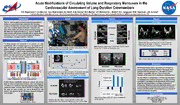
NASA Technical Reports Server (NTRS) 20100015797: Acute Modifications of Circulating Volume and Respiratory Maneuvers in the Cardiovascular Assessment of Long-Duration Crewmembers PDF
Preview NASA Technical Reports Server (NTRS) 20100015797: Acute Modifications of Circulating Volume and Respiratory Maneuvers in the Cardiovascular Assessment of Long-Duration Crewmembers
Acute Modifications of Circulating Volume and Respiratory Maneuvers in the Cardiovascular Assessment of Long-Duration Crewmembers V.V. Bogomolov1, I.V. Alferova1, S.A. Dulchavsky2, D. Ebert3, K.M. Garcia3, D.S. Martin3, V.P. Matveev4,S.L. Melton3, A.E. Sargsyan3, D.R. Hamilton3, J.M. Duncan5 Institute for Biomedical Problems (Moscow, Russia) 1; Henry Ford Hospital System (Detroit, MI)2; Wyle (Houston, TX)3; Gagarin Cosmonaut Training Center (Star City, Russia)4; NASA Johnson Space Center (Houston, TX)5 Introduction Results Results Results Peripheral vascular 2-D imaging This U.S. - Russian project is aimed at improved assessment of Tissue Doppler cardiac and vascular parameters associated with circulating volume and its distribution in long-duration space flight. Objective responses to modified Valsalva and Mueller maneuvers were no maneuver measured by cardiac and vascular ultrasound before, during, and t after temporary volume redistribution by means of Braslet-M e t e l s thigh occlusion cuffs (Russia). Braslet-M cuffs are custom fitted to l s a Valsalva each crewmember prior to launch on the Soyuz as a Russian a r B r B countermeasure for space adaptation fluid shifts. h o IJV t i N W Protocol Mueller Figure 9: Right heart tissue Doppler changes before Braslet, with The study protocol was conducted in 14 sessions on 9 ISS Braslet, and during release. S’- systolic; E’- early diastolic; A’- late crewmembers, with an average exposure to microgravity of 122 diastolic. Note the decrease in E’ with Braslet. Figure 6: Internal jugular vein (IJV) with and without Braslet. Note the days. All data were collected by ISS crewmembers with remote Figure 3: Dr. Mike Barratt performing self scanning tissue Doppler. Note the collapse of the IJV with Mueller and Braslet applied. guidance. Baseline cardiovascular measurements were taken by Braslet-M devices in place on his upper thighs. % change echocardiography in multiple modes (including tissue Doppler of Stdev Cardiac 2-D imaging both ventricles) and femoral and jugular vein imaging. The Braslet A' -1.66 24.03 devices were then applied and measurements were repeated after E' -29.60 16.00 ) >10 minutes. The cuffs were then released and the hemodynamic l m FV ( “recovery” process was monitored. e 50 Table: Left heart tissue Doppler changes as a result of Braslet m u l o V e 40 Discussion k o r t No Braslet With Braslet S release Redistributed volume (central hypovolemia) in microgravity 30 Figure 7: Femoral vein (FV) with and without Braslet. Note the distention appears to be best detected by collapse of the jugular vein in Beats with Braslet application, indicating fluid sequestration in the legs. response to Mueller maneuver and a decrease in E’ (tissue Figure 4: Cardiac stroke volume with Braslet release (left ventricle); inset: apical Doppler). A secondary indicator of hypovolemia is the four chamber cardiac 2-D image. Measurements are dependent on probe placement, prompting a greater reliance on tissue Doppler in later sessions 120 distension of the jugular vein in response to Valsalva maneuver. 100 Pulse wave Doppler jugular vein The data validate a methodology to 1) address specific aspects Figure 1: Diagrammatic view of the imaging protocol 80 of operational space medicine and space physiology, including femoral vein 60 e assessment of circulating volume disturbances, and 2) expand Modified Valsalva and Mueller maneuvers using an ISS drinking g n 40 diagnostic ultrasound imaging and Doppler techniques in straw as a means of providing resistance were used throughout a h c 20 microgravity. Respiratory maneuvers against the background of No Braslet the protocol. All ultrasound data were acquired by the HDI-5000 % 0 acute circulating volume manipulations enhance our ability to ultrasound system currently aboard the ISS (ATL/Philips, USA). noninvasively demonstrate volume-dependency of a number of -20 The study protocol, including the use of Braslet-M for this cardiac and vascular parameters. purpose, was approved by the ISS Human Research Multilateral -40 Review Board. -60 Contact Information With Braslet Valsalva Mueller Braslet Braslet + Braslet + Valsalva Mueller Doug Ebert Figure 8: Venous cross-section area change as compared to Wyle Integrated Science and Engineering 1290 Hercules Ste 103, Houston, TX, 77058 baseline (percent) Figure 5: Flow Doppler spectra of mitral valve inflow. Note the longer E-mail: [email protected] deceleration times with Braslet applied, indicating decreased cardiac preload. Phone: (281) 212-1243 Figure 2: Braslet-M application Fax: (281) 212-1263
